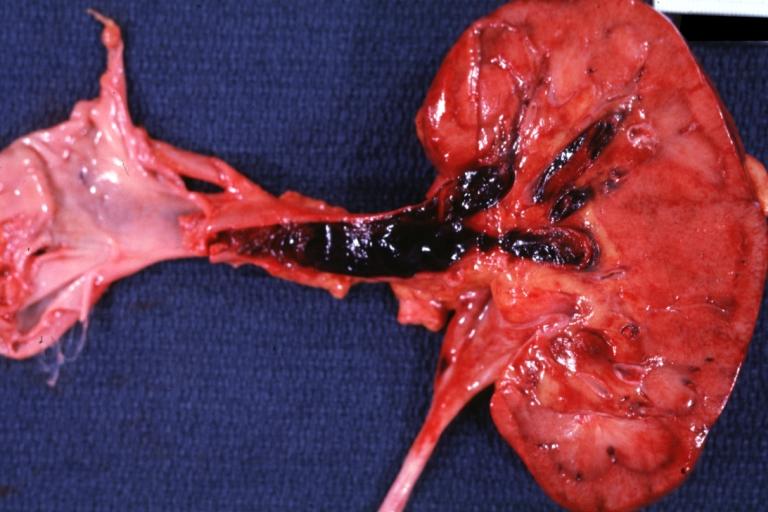Renal vein thrombosis: Difference between revisions
| Line 171: | Line 171: | ||
** For acute RVT | ** For acute RVT | ||
** Best outcomes especially in patients with nephrotic syndrome, | ** Best outcomes especially in patients with nephrotic syndrome, | ||
| | | | ||
| | | | ||
|- | |- | ||
!Surgery | !Surgery | ||
| | |acute bilateral RVT and acute renal failure who cannot be treated with percutaneous thrombectomy and/or thrombolysis | ||
| | | | ||
| | | | ||
Revision as of 15:46, 30 May 2018
| Renal vein thrombosis | |
 | |
|---|---|
| Transplant with Renal Vein Thrombosis: Gross; natural color, opened kidney and vein. Image courtesy of Professor Peter Anderson DVM PhD and published with permission © PEIR, University of Alabama at Birmingham, Department of Pathology | |
| ICD-10 | I82.3 |
| ICD-9 | 453.3 |
| DiseasesDB | 11359 |
| MedlinePlus | 000513 |
For patient information page, click here
Editor-In-Chief: C. Michael Gibson, M.S., M.D. [1] Associate Editor(s)-in-Chief: Saeedeh Kowsarnia M.D.[2]
Overview
Renal vein thrombosis (RVT) is the formation of a clot or thrombus obstructing the renal vein.
Classification
- Renal vein thrombosis is classified based on the onset of the symptoms:
| Renal vein thrombosis | ||
|---|---|---|
| Onset | Presentation | Etiology |
| Acute |
|
|
| Chronic |
|
|
- Based on the location RVT may be unilateral or bilateral.
Pathophysiology
A hypercoagulable state or mechanical compression of the renal vein is often present in those patients with renal vein thrombosis. This can be due to malignancy or it can be due to the nephrotic syndrome. In nephrotic syndrome there is an excessive urinary protein loss which is in turn associated with decreased antithrombin III. It is unclear why the renal vein is susceptible to thrombosis in patients with nephrotic syndrome.
Causes
Causes
- Malignancy (especially renal cell carcinoma [1] [2])
- Nephrotic syndrome
- Trauma (kidney biopsy)
- Oral contraceptive pills
- Hypovolemia
- Inherited coagulopathy
- Kidney transplant
- Antiphospholipid antibody syndrome
- Behçet's syndrome
Epidemiology and Demographics
Malignancy especially renal cell carcinoma is the most common etiology consists of
Prevalence of renal vein thrombosis in nephrotic syndrome is 5 to 60% [3] .Membranous nephropathy is responsible for 20 to 60 % of the cases which makes it the most common cause of renal vain thrombosis among nephrotic syndromes. Other etiologies like minimal change disease, membranoproliferative glomerulonephritis, and focal segmental glomerulosclerosis cause 10 to 50 % of the cases.
Risk Factors
- Nephrotic syndrome [4]
- Those with membranous nephropathy and protein excretion above 10 g/day
- Serum albumin concentration below 2 g/dL [20 g/L])
Screening
- Screening should be done for patients
- Who present with signs of renal infarct
- Who has chronic bilateral RVT with worsening creatinine and proteinuria to see weather anticoagulation is necessary
- There is no beneficial evidence regarding screening in patients with nephrotic syndrome and overt embolism.
Diagnosis
Sign and Symptoms
- Asymptomatic
- Renal infarct [5]
- Flank pain
- Microscopic or gross hematuria
- Marked elevation in serum lactate dehydrogenase (without change in transaminases)
- Increase in renal size on radiographic study
- Renal failure (bilateral RVT)
- Proteinuria (rarely)
Imaging
- Renal venography: gold standard test for RVT diagnosis
- Spiral computed tomography (CT) with contrast
- Magnetic resonance imaging (MRI)
- Doppler ultrasonography
Treatment
| Fibrinolytic therapy and catheter thrombectomy |
|
||
|---|---|---|---|
| Surgery | acute bilateral RVT and acute renal failure who cannot be treated with percutaneous thrombectomy and/or thrombolysis | ||
| Anticoagulation therapy |
Related Chapters
References
- ↑ Sailer, Christian, Wasner, Susanne. Differential Diagnosis Pocket. Hermosa Beach, CA: Borm Bruckmeir Publishing LLC, 2002:77 ISBN 1591032016
- ↑ Kahan, Scott, Smith, Ellen G. In A Page: Signs and Symptoms. Malden, Massachusetts: Blackwell Publishing, 2004:68 ISBN 140510368X
- ↑ Rajni Singhal & K. Scott Brimble (2006). "Thromboembolic complications in the nephrotic syndrome: pathophysiology and clinical management". Thrombosis research. 118 (3): 397–407. doi:10.1016/j.thromres.2005.03.030. PMID 15990160.
- ↑ T. J. Rabelink, J. J. Zwaginga, H. A. Koomans & J. J. Sixma (1994). "Thrombosis and hemostasis in renal disease". Kidney international. 46 (2): 287–296. PMID 7967339. Unknown parameter
|month=ignored (help) - ↑ F. Llach (1985). "Hypercoagulability, renal vein thrombosis, and other thrombotic complications of nephrotic syndrome". Kidney international. 28 (3): 429–439. PMID 3906225. Unknown parameter
|month=ignored (help)